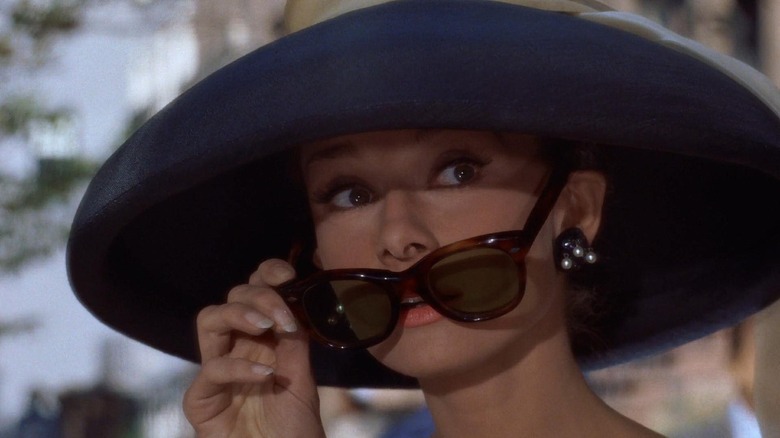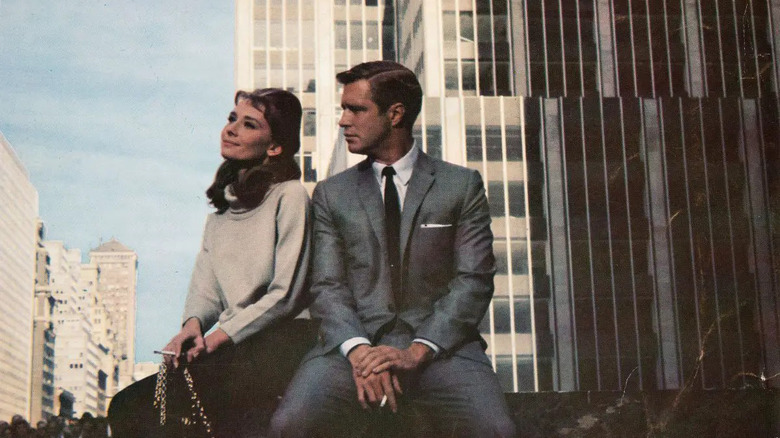This Breakfast At Tiffany's Scene Had To Be Dubbed For Audrey Hepburn
It is hard to think of a movie made in any country, at any time, by studio or otherwise, that has been reduced more completely into a set of decontextualized images while the rest of the movie has been more or less thrown out than "Breakfast At Tiffany's." Blake Edwards' 1961 adaptation of the Truman Capote novel from just a few years earlier was well-received upon its release, garnering five Academy Award nominations, winning two (for Henry Mancini's score and the song "Moon River") and collecting a smattering of praise in the national trades.
But what started out as a piercing character study of a self-destructively aloof sex worker (Capote called Holly Golightly an "American geisha") who runs from the cops to Brazil after being implicated in a criminal drug ring has over been oddly and dramatically sanitized. The sheer power of the costuming, frame composition, and styling of star Audrey Hepburn led to the creation of several images that by now far surpass the memory of the movie, and have, in a way, written over it. But "Breakfast at Tiffany's" is at its heart a story about the persuasive power and the ultimate limits of glamorous deception. That images like the one of Hepburn dolled up in a baroque, self-parodying kind of class drag, cigarette holder in hand and fake diamond-encrusted tiara pinned into her updo, have come to pass for images of real wealth and sophistication only prove the enduring resonance of the story's critique.
In reality there's much more to "Breakfast At Tiffany's" than meets the eye, and as an interview from later in Hepburn's life proved, the tricky depths to the film extended even to its production.
Whistle and I'll come to you
"Breakfast at Tiffany's" might today be most closely associated with the career of its star, Audrey Hepburn. 1961 found Hepburn in a bit of a dip, several years removed from the hot period of "Roman Holiday," "Sabrina," and "Funny Face." She'd go on to make even more daring and interesting work after "Tiffany's," including the powerfully ahead-of-its-time lesbian drama "The Children's Hour" and the psychological thriller "Wait Until Dark." But "Tiffany's" was a much-needed boost that brought the sizzle back to Hepburn's star persona.
A huge reason the film worked so well, and why Hepburn shined so brightly within it, was that Oscar-winning music. Hepburn's beautiful, ruminative version of "Moon River" remains one of the most indelible musical numbers from a film of the period. Prolific composer Henry Mancini's alternately bright, groovy, and melancholic score also sweeps the viewer away on a pink cloud of romance and wistfulness. One of the more memorable musical moments from the film is when Holly lets out a sharp whistle for a cab. In a career-spanning 1988 interview, Hepburn was asked if, like the singing and guitar playing, she did the whistling herself. She responded with her usual candor and grace, "No. It was dubbed in. I'd love to say I did. I tried so hard. I did get something, but it was more like a squeak. But the real thing was dubbed in."
The fact that movie magic was used to create one of "Tiffany's" most indelible moments fits perfectly with the story's themes of deception, seduction, and schadenfreude. And the fact that forevermore the whistle has been taken to be genuine, well that movie magic really worked.

